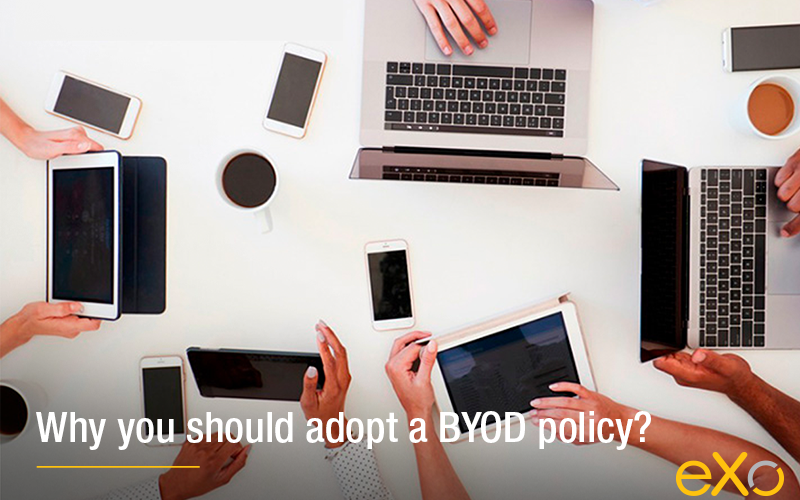- Fares Laroui
- August 28, 2019
Top 5 reasons to implement a BYOD policy
Technological advancements and the emergence of a young and tech savvy workforce paved the way for new trends to emerge in the workplace. Among the most hyped trends in recent years is BYOD or Bring Your Own Device. BYOD is a policy that organizations are increasingly adopting which encourages employees to bring and use their own devices at work.
This trend gained popularity recently with the widespread use of mobile devices, familiarity of employees with the latest technologies and their willingness to work remotely. According to an intel study, 61% of Gen Y and 50% of employees over the age of 30 believe that the technology tools they use in their everyday life are more effective than those provided by their IT departments.

Content
The definition of BYOD is constantly changing as organizations are progressively adapting to the new dynamics in the workplace. Just try to type “Bring Your Own…” on Google and a long list of suggestions will appear (of course Bring Your Own food or wine do not count… these are subjects for another blog). Other suggestions that relate to our topic include BYOT (Bring Your Own Technology), BYOA (Bring Your Own Application) and BYOS (Bring Your Own Software). What these policies have in common is the readiness of organizations to be more flexible by allowing their employees to work with their own tools whether hardware or software. In a modern work environment, a typical employee expects to use his/her own laptop, mobile device or tablet to perform his/her daily activities. Chat applications like Slack or Microsoft Teams are also progressively used by departments to communicate and collaborate on a daily basis.
The flexible nature of these policies means that they will always be met with skepticism with questions still asked about whether they are secure, efficient or even legal. In this blog post, we will try to make the case for BYOD and why you should implement a BYOD policy within your organization.
1. Cost savings
It goes without saying that the cost of purchasing IT hardware and software represent a big portion of a company’s budget. According to Gartner, global IT spending is expected to grow by 3.2% from $3.7 Trillion in 2018 to $3.8 Trillion in 2019. This growth is not expected to slow down as new technologies are making their way to the office putting extra pressure on companies to implement them.
Adopting a BOYD policy will allow companies to cut down spending on enterprise technologies and training. According to a cisco report, cost savings may reach $350 per year per employee with reactive programs cutting spending to as much as $1.300 per year per employee. This can have a positive effect especially on SMEs with limited budgets.
2. A more engaged workforce
The new generation of workers (millennials and Gen Z) expect flexible work hours and the ability to work from different locations. This requires high performing tools similar to what they use on their personal life. The inability to provide such tools or imposing new ones may have a negative impact on their level of engagement and well-being.
A BOYD policy helps keep your workforce engaged and allows them to maintain a healthy work-life balance as they will be working with devices and solutions they are familiar with. In fact, according to research study conducted by IDG research services, 78% of employees believe that using a single device use helps them balance their personal and professional lives.
3. More control
The absence of flexible policies and a clear IT strategy and vision can lead to unwanted practices in the workplace. If employees do not see a real value in the systems and tools they have in place, they tend to use their own but without the knowledge of the IT department. This phenomenon is referred to as shadow IT. Shadow IT can have disastrous effects on businesses from the inability of the IT department to control the software in use to compliance issues and costs associated with data loss.
A BYOD policy can be adopted to reduce the effects of shadow IT. At the end of the day, your employees will still be using their own devices regardless of your IT policies. That is according to a Microsoft study that found 67% of people use their personal devices at work regardless of the organization’s official BYOD policy. The study also found that employees (especially millennials) have the tendency to use their devices even within companies with strict IT policies.
This means that the wise choice for organizations is to listen to their workforce and be flexible in their approach. This way they can properly control both hardware and software in use and be in a position to properly plan for long term IT strategies.
4. Enhanced productivity
Giving your employees the freedom to use their own devices and work from any location can increase their productivity. That is according to a study by BT Global Services, that found 42% of employees who use their personal devices saying that their productivity has improved.
Another study made by BMC software states that BYOD employees are more productive with 2 additional hours daily and 20 more e-mails.
5. No training
When introducing a new technology to their workforce, IT departments often face the same challenges. A part of the workforce is too old to learn the technology and the other probably have better technology of their own. Both parties need intensive training to learn how to use the technology and often rely on the IT department to answer their questions. A BOYD policy can minimize training as employees are familiar with their own devices and allow IT teams to concentrate on more strategic tasks.
Bring Your Own…Device…Technology…Software and Application are policies that are on the rise with each year passing. Although they bring countless benefits to your organization, they can pose certain problems especially in terms of security and compliance. A well thought and implemented BYOD policy taking into account the nature of your business, the devices you will be allowing and the apps available should mitigate these risks and helps you engage and retain your workforce.
eXo Platform 6 Free Datasheet
Download the eXo Platform 6 Datasheet and
discover all the features and benefits
discover all the features and benefits
4/5 - (1 vote)
I am a product marketing specialist at eXo. My role is to assist marketing and sales teams in their operations and present our digital workplace solution to the world. I mainly blog about the latest tech trends, digital transformation, internal communication and how to navigate through eXo Platform.
Related posts
- All
- eXo
- Digital workplace
- Employee engagement
- Open source
- Future of work
- Internal communication
- Collaboration
- News
- intranet
- workplace
- Knowledge management
- Employee experience
- Employee productivity
- onboarding
- Employee recognition
- Change management
- Cartoon
- Digital transformation
- Infographic
- Remote work
- Industry trends
- Product News
- Thought leadership
- Tips & Tricks
- Tutorial
- Uncategorized
Leave a Reply
( Your e-mail address will not be published)
Connexion
0 Comments
Commentaires en ligne
Afficher tous les commentaires


